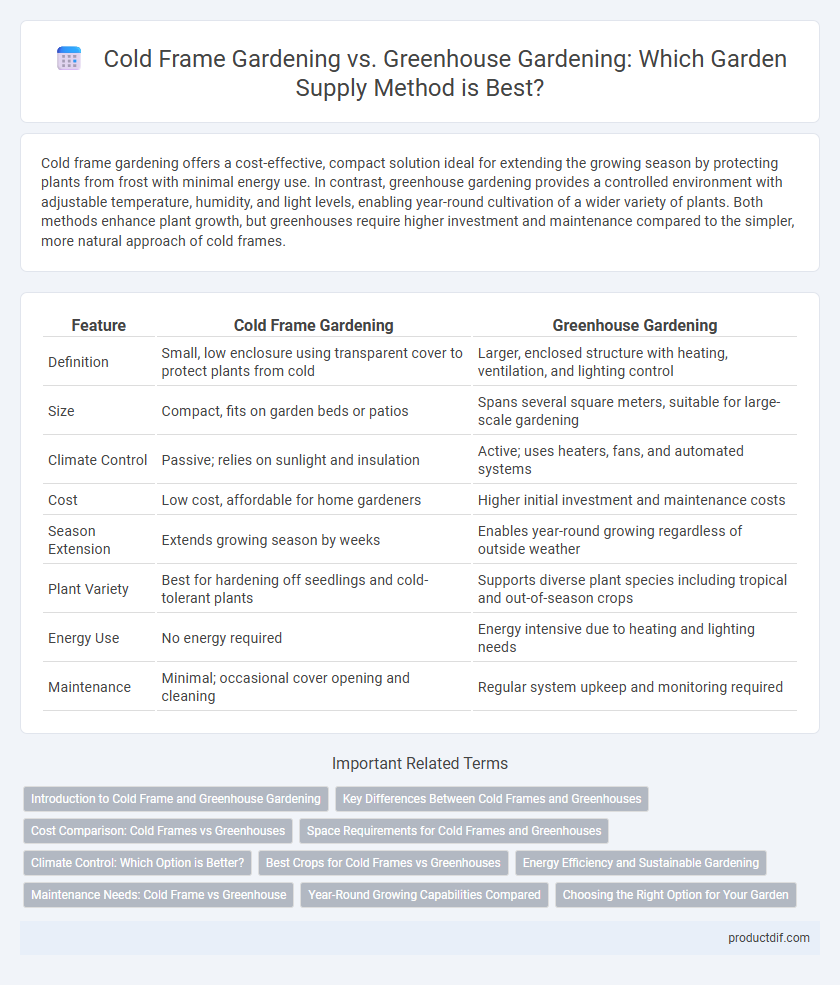Cold frame gardening offers a cost-effective, compact solution ideal for extending the growing season by protecting plants from frost with minimal energy use. In contrast, greenhouse gardening provides a controlled environment with adjustable temperature, humidity, and light levels, enabling year-round cultivation of a wider variety of plants. Both methods enhance plant growth, but greenhouses require higher investment and maintenance compared to the simpler, more natural approach of cold frames.
Table of Comparison
| Feature | Cold Frame Gardening | Greenhouse Gardening |
|---|---|---|
| Definition | Small, low enclosure using transparent cover to protect plants from cold | Larger, enclosed structure with heating, ventilation, and lighting control |
| Size | Compact, fits on garden beds or patios | Spans several square meters, suitable for large-scale gardening |
| Climate Control | Passive; relies on sunlight and insulation | Active; uses heaters, fans, and automated systems |
| Cost | Low cost, affordable for home gardeners | Higher initial investment and maintenance costs |
| Season Extension | Extends growing season by weeks | Enables year-round growing regardless of outside weather |
| Plant Variety | Best for hardening off seedlings and cold-tolerant plants | Supports diverse plant species including tropical and out-of-season crops |
| Energy Use | No energy required | Energy intensive due to heating and lighting needs |
| Maintenance | Minimal; occasional cover opening and cleaning | Regular system upkeep and monitoring required |
Introduction to Cold Frame and Greenhouse Gardening
Cold frame gardening uses low-profile, transparent structures to protect plants from frost and extend the growing season, making it ideal for starting seedlings early. Greenhouse gardening involves fully enclosed, climate-controlled spaces that allow year-round cultivation of a wide variety of plants, offering greater temperature and humidity regulation. Both methods enhance plant growth by creating controlled environments, but greenhouses provide more advanced protection and versatility compared to cold frames.
Key Differences Between Cold Frames and Greenhouses
Cold frame gardening uses simple, low-profile structures with transparent tops to trap solar heat, ideal for extending growing seasons and protecting seedlings from frost. Greenhouse gardening involves larger, enclosed environments with controlled temperature, humidity, and ventilation systems, allowing year-round cultivation of diverse plants. The key differences include scale, environmental control, and cost, with greenhouses providing advanced climate regulation compared to the passive heat retention of cold frames.
Cost Comparison: Cold Frames vs Greenhouses
Cold frame gardening offers a significantly lower initial investment, typically ranging from $50 to $200, making it an affordable option for small-scale or beginner gardeners. Greenhouses, in contrast, involve higher setup costs, often between $500 and $5,000 depending on size, materials, and features, but provide greater climate control and extended growing seasons. Maintenance expenses for cold frames remain minimal due to their simple design, whereas greenhouses require more ongoing costs for heating, ventilation, and repairs.
Space Requirements for Cold Frames and Greenhouses
Cold frames require significantly less space compared to greenhouses, making them ideal for small gardens or urban settings with limited area. Greenhouses typically demand a larger footprint due to their full enclosure structure, which allows for controlled growing environments and extended plant cultivation. Efficient use of vertical space in greenhouses maximizes plant density, whereas cold frames are generally ground-level structures focusing on protection and heat retention for seedlings.
Climate Control: Which Option is Better?
Cold frame gardening provides basic climate control by trapping solar heat and shielding plants from frost, ideal for extending the growing season in mild climates. Greenhouse gardening offers advanced climate control with adjustable temperature, humidity, and ventilation systems, enabling year-round cultivation and protection from extreme weather. For optimal climate management and consistent crop production, greenhouses are generally the superior choice.
Best Crops for Cold Frames vs Greenhouses
Cold frame gardening excels with hardy, cold-tolerant crops like lettuce, spinach, kale, and radishes, which benefit from the protection against frost and wind. Greenhouse gardening supports a broader range of crops, including tomatoes, peppers, cucumbers, and tropical plants, by providing controlled temperature, humidity, and light conditions year-round. Selecting the right crops depends on climate, space, and desired growing conditions, with cold frames ideal for early spring and fall crops and greenhouses suited for long-term cultivation of warm-season and exotic plants.
Energy Efficiency and Sustainable Gardening
Cold frame gardening utilizes passive solar energy and natural insulation with minimal energy input, making it highly energy-efficient and eco-friendly. Greenhouse gardening often requires supplemental heating and ventilation systems that consume more energy but allow for greater climate control and year-round growing. Choosing cold frames promotes sustainable gardening by reducing carbon footprints and resource use, while greenhouses enable intensive cultivation with potential energy trade-offs.
Maintenance Needs: Cold Frame vs Greenhouse
Cold frame gardening demands minimal maintenance, primarily involving occasional monitoring of temperature and moisture levels along with seasonal cleaning. Greenhouse gardening requires more intensive upkeep, including regular ventilation, humidity control, pest management, and structural inspections to maintain optimal growing conditions. Both methods benefit from consistent care, but greenhouses typically necessitate greater time and resource investment due to their complex environment.
Year-Round Growing Capabilities Compared
Cold frame gardening offers season extension by protecting plants from frost and moderate cold, enabling earlier planting and extended harvests, but is generally limited in temperature control and space. Greenhouse gardening provides a fully controlled environment with automated heating, ventilation, and humidity regulation, supporting true year-round growing across diverse crops and climates. For continuous production and scalability, greenhouses outperform cold frames by maintaining optimal conditions regardless of external weather fluctuations.
Choosing the Right Option for Your Garden
Cold frame gardening offers a cost-effective, space-saving solution ideal for extending the growing season by protecting plants from frost in small or urban gardens. Greenhouse gardening provides a controlled environment with regulated temperature, humidity, and light, supporting year-round cultivation of a wider variety of plants. Selecting between cold frames and greenhouses depends on factors such as budget, available space, climate, and the cultivation goals of your garden.
Cold frame gardening vs Greenhouse gardening Infographic

 productdif.com
productdif.com